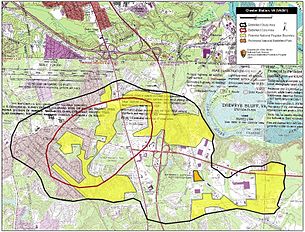Battle of Chester Station
| Action at Chester Station | |||||||
|---|---|---|---|---|---|---|---|
| Part of the American Civil War | |||||||
| |||||||
| Belligerents | |||||||
|
|
| ||||||
| Commanders and leaders | |||||||
|
Benjamin Butler[2] | P. G. T. Beauregard[2] | ||||||
| Strength | |||||||
| 3,400 | 2,000[3] | ||||||
| Casualties and losses | |||||||
| 280 | 249 | ||||||
The Battle of Chester Station was fought on May 10, 1864, between
Background
The Action at Chester Station was a relatively minor battle of the Bermuda Hundred Campaign and ended indecisively. It started as a Union expedition against the
Battle

When the Federal (Union) troops reached the vicinity of Chester Station they were divided into two wings. The left wing, commanded by Maj. O. S. Sanford of the
To add to these difficulties the woods were fired early in the action, and the smoke and flames driving into our lines blinded us and deranged the precision of movements.
— Brig. Gen. Seth Barton C.S.A.
Aftermath
Gen. Terry reported the Union loss as being 280 in killed, wounded and missing, and estimated that of the Confederates as at least twice that number, some 50 prisoners remaining in the hands of the Federals.
The return of casualties in
Two Confederate brigades faced an Ohio regiment, which was pushed back despite arrival of reinforcements from
Order of battle
Union Forces
Department of Virginia and North Carolina
MG
MG Quincy A. Gillimore, commanding X Corps
| Division | Brigade | Regiments and Others |
|---|---|---|
|
1st Division, X Corps |
1st Brigade |
|
| 2nd Brigade Col Joseph R. Hawley
|
| |
| 1st Division, XVIII corps | 1st Brigade Col Jeremiah C. Drake |
|
| Cavalry |
|
Confederate Forces
Department of North Carolina and Southern Virginia
GEN
MG
| Brigade | Regiments and Others |
|---|---|
| Barton's Brigade |
|
| Gracie's Brigade [4][5] |
|
See also
- Bermuda Hundred Campaign
Notes
- ^ National Park Service battle summary
- ^ a b CWSAC Report Update
- ^ the Union estimate of 6,000 probably included Gracie's brigade
- ^ not engaged in the fight except for skirmishing around Ware Bottom Church
- ^ "43RD ALABAMA INFANTRY REGIMENT". Archived from the original on 2012-09-21. Retrieved 2011-04-17.
References
- The Union Army: Cyclopedia of battles, Volume 6, Federal Publishing Company, 1908, page 274.
- Dwight, Theodore Frelinghuysen, General Butler's Bermuda Campaign, Papers of the Military Historical Society of Massachusetts, Volume 9, Military Historical Society of Massachusetts, 1912.
- Cowles, Calvin Duvall, Report of Col. Cyrus J. Dobbs, Thirteenth Indiana Infantry, of operations May 10. The War of the Rebellion: A Compilation of the Official Records of the Union and Confederate Armies, United States War Records Office, Series 1 - Volume 36 (Part II), CHAP. XLVIII, page 110, Govt. Print. Off., 1891.
- Cowles, Calvin Duvall, Report of Col. Alvin C. Voris, Sixty-seventh Ohio Infantry, of operations May 9-10, 1864. The War of the Rebellion: A Compilation of the Official Records of the Union and Confederate Armies, United States War Records Office, Series 1 - Volume 51 (Part I), Chapter LXIII, page 1224 Govt. Print. Off., 1891.
- Cowles, Calvin Duvall, Report of Brig. Gen. Seth M. Barton, C. S. Army, commanding brigade, of operations May 10. The War of the Rebellion: A Compilation of the Official Records of the Union and Confederate Armies, United States War Records Office, Series 1 - Volume 36 (Part II), CHAP. XLVIII, page 213, Govt. Print. Off., 1891.
- Cowles, Calvin Duvall, Report of Col. George K. Griggs, Thirty-eighth Virginia, Infantry, of operations May 3–27. The War of the Rebellion: A Compilation of the Official Records of the Union and Confederate Armies, United States War Records Office, Series 1 - Volume 36 (Part II), CHAP. XLVIII, page 235, Govt. Print. Off., 1891.
- Attribution
- This article contains text from "The Union Army: Cyclopedia of battles", Volume 6, Federal Publishing Company, 1908 a text now in the public domain.
Further reading
- Salmon, John S., The Official Virginia Civil War Battlefield Guide, Mechanicsburg, PA: Stackpole Books, 2001. ISBN 0-8117-2868-4.
- Lowry, Don No turning back: the beginning of the end of the Civil War : March–June 1864, Volume 1, Hippocrene Books, 1992.
- Robertson, William Glenn, Back door to Richmond: the Bermuda Hundred Campaign, April–June 1864, University of Delaware Press, 1987.
External links
- The Bermuda Hundred Campaign
- The Bermuda Hundred Campaign
- The Troy Times, MAY 16, 1864.
- The New York Times, Wednesday, May 11, 1864.
- National Park Service battle summary
- Battle of Chester Station Historical Marker
- Battle of Chester Station Historical Marker
- Chester Station Fight Historical Marker
- Chester Station Camp #1503 Sons of Confederate Veterans
- Virginia Civil War Trails
- CWSAC Report Update
